The Value of School Gardens
School gardens are a wonderful way to use the schoolyard as a classroom, reconnect students with the natural world and the true source of their food, and teach them valuable gardening and agriculture concepts and skills that integrate with several subjects, such as math, science, art, health and physical education, and social studies, as well as several educational goals, including personal and social responsibility.
If you're the creator or supporter of a school garden, there's
a thank you gift for you below.

...Young people increasingly are isolated from the land and deprived of the joys and responsibilities it teaches.
— Alice Waters
To a great extent we are a deplaced people for whom our
immediate places are no longer sources of food, water, livelihood,
energy, materials, friends, recreation, or sacred inspiration.
— David Orr
A Very Brief History of School Gardens
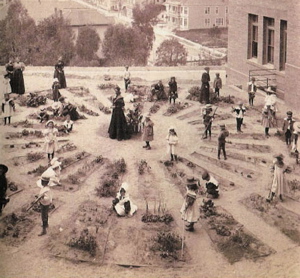
School gardens are not new. When I visited the Philippines in 1994, I saw a garden in every schoolyard. One elementary school principal explained to me that the students worked in the garden and, in return, received a nutritious lunch every day. Going a lot further back, school gardens were quite common in Victorian times in England as part of nature study classes, during the world wars in many countries where food shortages occurred, and in the post-civil war era in the USA.
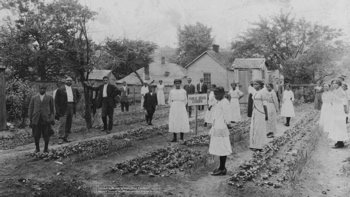
Suzi Teghtmeyer, the plant sciences librarian for Michigan State University, has compiled a fascinating set of primary documents related to school gardening from the late 1800s to the present, especially — but not only — in the United States. Check out School Gardening in the Early 1900s Through Today.

The importance of encouraging our children in outdoor work with living plants is now recognized. It benefits the health, broadens the education, and gives a valuable training in industry and thrift. The great garden movement is sweeping over all America, and our present problem is to direct it and make it most profitable to the children in our schools and homes.
— Van Evrie Kilpatrick, 1918, in The Child’s Food Garden, With a Few Suggestions for Flower Culture
The Benefits of School Gardens
Experience and research have shown numerous benefits of school gardens and natural landscaping:
- students learn focus and patience, cooperation, teamwork and social skills
- they gain self-confidence and a sense of "capableness" along with new skills and knowledge in food growing — soon-to-be-vital for the 21st century
- garden-based teaching addresses different learning styles and intelligences; our non-readers can blossom in the garden!
- achievement scores improve because learning is more relevant and hands-on
- students become more fit and healthy as they spend more time active in the outdoors and start choosing healthy foods over junk
food
- the schoolyard is diversified and beautified
- graffiti and vandalism decrease because students respect what they feel some ownership in
J. Michael Murphy, an associate professor of psychology at Harvard Medical School, studied the Edible Schoolyard program in Berkeley, California for two years. He discovered that school gardens are both "shrinking students' waistlines and increasing their understanding of food and the environment." He observed that "when middle school students in large urban communities are given the opportunity to learn about ecology in a real-world context, they are more enthusiastic about attending school, make better grades, eat healthier food due to wiser food choices, and become more knowledgeable about natural processes."

Information alone can never become knowledge, and knowledge never becomes wisdom without some kind of rooting in the good soil of experience.
— James Raffan
I love this account, by Ann Simms, of the academic rigour in the Edible Schoolyard program:
"The Edible Schoolyard's botany and culinary classes are no slacker electives. Rather, they're fully integrated into the school's traditional academic curriculum. Students learn about photosynthesis by observing plant leaves in the garden as well as by studying chemical formulas in their textbooks. In the indoor kitchen classroom, students discover the history and concept of food preservation during the Neolithic period, as they taste the very grains that have been harvested for millennia. After getting their hands dirty in the garden and then cleaning them up for work in the kitchen, students record their observations in a journal. This exercise gives the kids a chance to process what they've done. The written track record also gives educators a better chance to monitor learning and development."
Click on the garden photo below to read A Green School Vision in the Making, which I wrote soon after I started working at this school. The "learning garden" project was only a few months old then, but I was so excited by the kids' excitement that I had to tell as many people as possible!
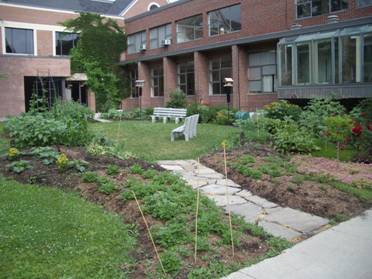
You should see that garden now ... a grape arbour for shade, Three Sisters plantings, a pizza garden, an Asian veggie garden, and a variety of fun vegetables (plus alpine strawberries) for the kids to enjoy, some before the summer holiday and many more that welcome them back to a new school year. This garden became a hands-on science lab, a refuge during breaks, a poetry trail for language arts lessons, a focus for sketching and other art activities, and a showcase for our school's Green School initiative.

We could have Chez Panisse food in the cafeteria and the kids wouldn't eat it. The key is learning how to grow the very fruits and vegetables they reject at the family dinner table. This may sound like a cliché by now, but it's true. If they grow it, they'll eat it.
— Marsha Guerrero, executive director of The Edible Schoolyard
Getting Your School Garden Started
You can start a "school garden" simply and quickly, by using sunny window sills or window boxes (see Little Green Thumbs, for example), or by setting up a container garden in a courtyard or somewhere in the playground. However, to really dig in, here's some advice (mainly from Texas A & M University Aggie Horticulture):
- seek help from at least one colleague, parent or community member who is into organic gardening, even if you're an experienced gardener
- evaluate your site
- does it get a minimum of six hours of full sun per day?
- is there easy access to water?
- is it close enough to classrooms to get used? (out of sight could become out of mind)
- can it be protected from marauding visitors of the two-legged and four-legged varieties?
- test the soil texture, drainage, and composition (this can be part of a science lesson)
- plan/design your garden according to your site and your goals (be sure to use some plants that will produce before the summer break and lots that will be ready when the students return)
- do you want a separate plot or raised bed for each class?
- do you want to include garden plots for community members?
- do you want a greenhouse or cold frame to extend your growing season?
- will you include a compost centre? (beware rodents!)
- will you need a tool shed?
- do you want to incorporate an outdoor classroom area and/or shade structure?
- choose a theme for your garden — and enjoy!
Don't worry about success or failure. Keep in mind that if something in the garden dies, that's a science lesson (the circle of life). And if it ripens and your students get to eat it and share some with the food bank, that's a nutrition lesson, and a lesson in altruism, too.
School Garden Themes
Special themes make the school garden more fun, and offer lots of opportunities for creative and critical thinking. You might want to try a different one each year, or a different one for each grade or class.
- ABC garden (A is for artichokes or alyssum, B is for broccoli or begonias, etc.)
- vegetable soup garden (ask your students what veggies they would like to grow to put in their soup next autumn)
- enchanted garden or adventure garden (with pole bean teepees, a corn maze, sunflower forts and other places to hide and let the imagination run wild)

- sensory garden or scratch and sniff garden
- tea garden, herb garden or perfume garden (students at one school I worked in made herbal tea bags from their scratch and sniff garden to sell at school events as a fundraiser for their Green Club; making and selling bouquets garnis or scented sachets would also work)
- butterfly garden
- sundial garden
- dragon's garden (thank you, Steven Biggs and Emma, and Finn!)
- Peter Rabbit garden or salad garden
- storybook garden (see Junior Master Gardener's Literature in the Garden)
- music garden (imagine working with your school's music and technology specialists!)
- jelly garden ("The idea of creating a garden specifically for making jellies sounds really fun. I think kids could really get into a project like this. Mixing and matching fruits and their flavors to create the best jelly would be a lifelong journey of getting to know a place: a labor of love and a declaration of your terroir." — Amy Stross)
- bird (or hummingbird) garden
- dinosaur garden (using plants that have survived since prehistoric times)
- history garden ("If you have a pocket of native plants, you have an historical treasure. Consider it an antique that needs your help to make it through the coming hundreds of years." — Merv Wallace)
- pizza garden (below is a photo of my students creating their pizza garden one year)
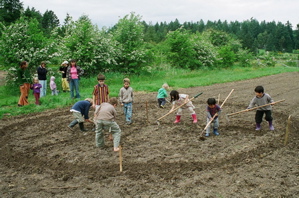
- art garden (mimicking a famous painting, growing dye plants, or ensuring beautiful places to observe and sketch the natural world)
- multicultural garden (I participated in a tour of community gardens in Toronto a few years ago and saw peanuts growing, and jute, calliloo, okra and other plants I'd never seen before)
- discovery or experimental garden (a local farmer once told me that the best gardeners he'd ever met were soil scientists, because they understood that different plants thrive on different types of soil — imagine the experimental possibilities!)
- permaculture garden or edible landscaping
- a garden of nature's medicines (herbal plants)
- friendship garden (perhaps using companion plantings?)
- indigenous garden (for example, Three Sisters plantings are fun and educational, and here's an example of an Indigenous Education Garden)
- crayon colour garden or rainbow garden (purple potatoes or rainbow carrots, anyone?)
- peace garden (which becomes "a symbol of hope for the future and our school's commitment to peace — peace within ourselves and our school community, peace within the global family and peace with the rest of nature" — Broward County Public Schools How to Create a Peace Garden)
- school goals garden (as an illustration, check out this Equity and Inclusive Education Garden, which uses plants and their properties to symbolically represent what the school believes in)
- fruit garden (with dwarf or espaliered fruit trees, strawberry beds, vining grapes or kiwis, and a "berry walk")
- giant plants (pumpkins, squash, corn, hollyhocks, sunflowers)
- rain garden (landscaping to prevent runoff)
- moon garden (white flowers that glow at night, others that open only at night or that attract night creatures)
- winter garden (in temperate zones, or to provide winter food for birds)
- memorial garden
- accessible garden (with beds raised high enough for students or staff who use wheelchairs or walkers to be able to access them; visit AccessibleGardens for more information and examples)
- a climate change friendly garden, where students can learn about "carbon farming" and regenerative ways to care for the soil
Twelve Fun and Easy Vegetables to Plant in Your School Garden
- sugar snap peas, great for planting along garden fences early in the growing season
- lettuce, spinach, and other leafy greens, with new seeds planted every two weeks for continued harvest (another early season one)
- radishes grow quickly and are ready to eat in a month (plant early in the season and they won't get too spicy)
- carrots grow quickly, too, though the seeds are quite tiny and hard to handle (try carrot seed tape)
- potatoes, planted early, could be ready for harvest before the summer break (just cut seed potatoes with an eye in each piece and bury)
- green beans, bush or pole, are great raw or cooked
- cherry tomatoes and tomatillos are fun for kids — make some salsa together (Shhhh, secret tip for school and community gardens: to discourage two-legged garden marauders, choose a tomato variety that is orange when ripe; fewer uninvited visitors will take them, thinking they haven't ripened yet..)
- pumpkins take more space and won't be ready until fall, but are perfect for teaching patience
- broccoli is not known as a favourite of children — until they've grown their own (buy starter plants to speed this one up; consider purple sprouting broccoli)
- sunflowers — okay, not a vegetable, but in the fall, your students can dry and eat the seeds, or leave the flower heads in the garden as a treat for birds
- Asian greens, such as pac choi, because they germinate and grow so rapidly in cooler weather
- kale, because there's no better way to make a hand salad (see below)!
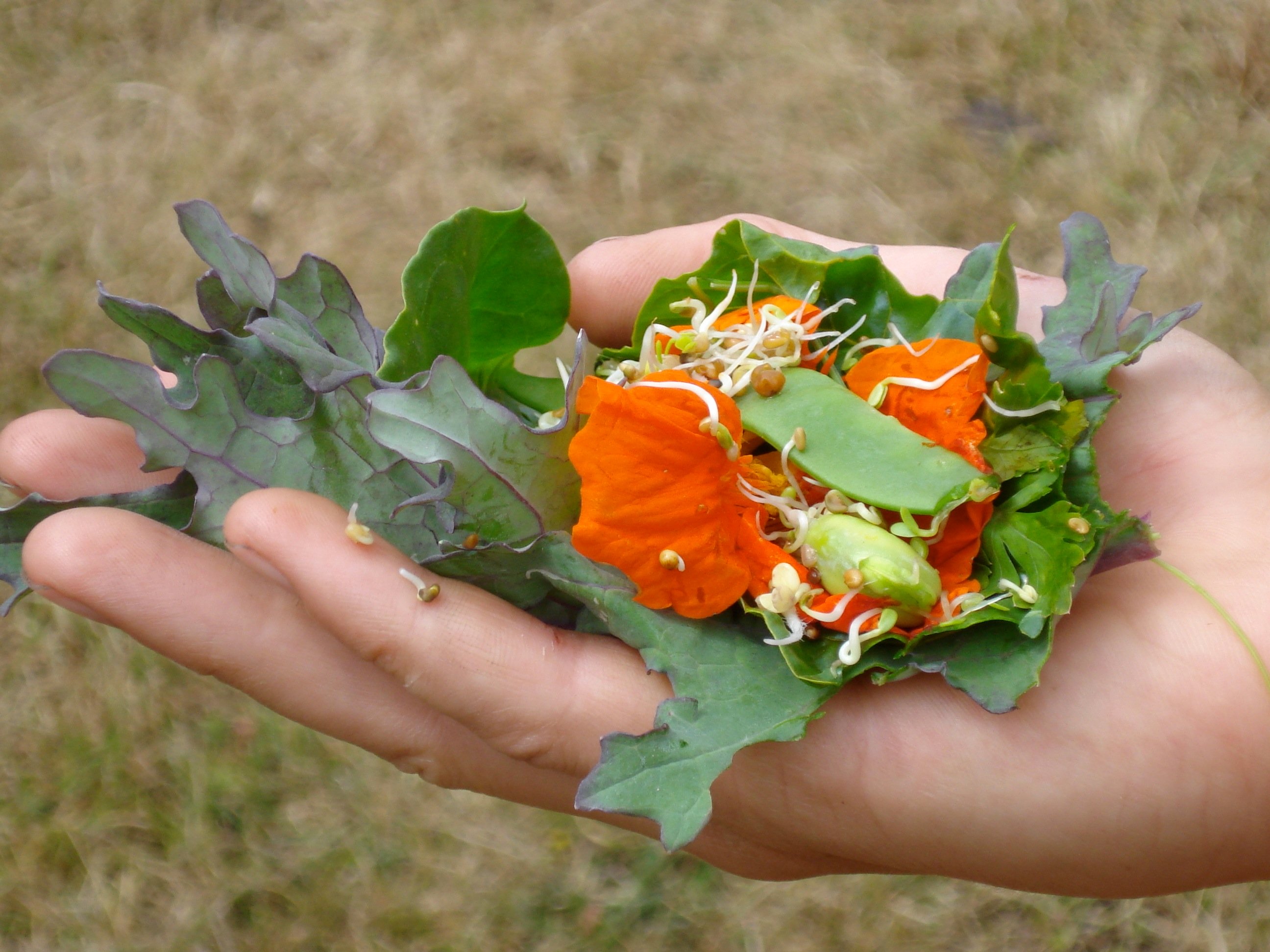
Some Final Suggestions
- Please ensure that your school garden is grown organically, with no toxic pesticides or synthetic fertilizers.
- Invite parents and community gardeners to help out. You don't have to do it all.
- Be sure to organize ahead of time for volunteers (usually one student's family per week, depending on the size of the garden) to come in over the summer months to water and weed the garden. In some schools, the volunteers take half of whatever is ripe during their week to the local food bank, and take the rest home as a thank you.
- Watch to see if gardening "vocabulary" seeps into usage amongst your students and colleagues. The organic language of gardening is so much "greener" and more life-affirming than the techno language of computers.
- Track your school garden's growth through photos, student artwork and poems, and a journal. Create and display a calendar of gardening activities: planting dates, special events, volunteer schedules, etc. Keep your garden in the spotlight by sharing your photos, accomplishments and milestones in the school newsletter and on bulletin boards, and by holding harvest celebrations. Let your local media know about your successes.
- Plan for success (even if you don't attain it at first). Use plants that grow well in your area and that will mature quickly as well as some that will be ready for the new school year. Gardening is a lesson in patience and delayed gratification, but an early salad with pea shoots and the flowers of over-wintered kale will win over the students. Keep garden lessons fun and hands-on.
- And finally, because your original group of student gardeners will eventually move on, be sure to involve and instill ownership in new students each year, by allowing them to make design and planting decisions.
Resources for School and Children's Gardening
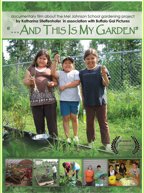
My Favourite Movie
- "...And This Is My Garden" is a wonderfully inspiring account by Katharina Stieffenhofer of the Mel Johnson School gardeners and their teacher, Eleanor Woitowicz
Great Websites
- The Edible Schoolyard (check out their garden tour on video)
- Kidsgardening.org (everything you'll need to get kids, well, gardening!)
- Center for Ecoliteracy (initiatives that link food, culture, health and the environment)
- Evergreen (great advice and support for naturalizing your schoolyard)
- Square Foot Gardening (a great way to garden, especially in small spaces or for people with disabilities)
- City Farmer (includes links to stories about urban gardening with children)
- Intergenerational Landed Learning (ideas for uniting generations in a community learning initiative based on agriculture and food as the link between a healthy environment and human well-being)
- OISE Learning Garden (the Ontario Institute for Studies in Education in Toronto has developed themed garden beds to match the foundational concepts of its programs)
- Butterfly Gardening Resource Guide (a fabulous compilation of online resources about gardening to attract pollinators, by Eric Vinje over at PlanetNatural.com)
My Favourite Books
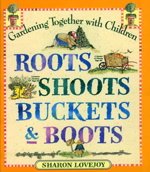
- Roots, Shoots, Buckets and Boots: Gardening Together with Children, by Sharon Lovejoy
- The Global Garden, a fabulous pop-up book by Kate Petty and Jennie Maizels, with paper
engineering by Corina Fletcher
- Get Growing! Activities for Food and Garden Learning, edited by Jolie Mayer-Smith and Linda Peterat
A Compilation of School Gardening Quotes
As a way to show our appreciation to educators and community members who support school gardens, GreenHeart Education offers you this downloadable set of ready-to-print quotes for your School Garden Club bulletin board or to include in school newsletters.
Download these school garden quotes here [pdf],
with our thanks for the important work you're doing.

A great way to teach ecological literacy and respect for the Earth, along with important food production skills, is to help your students grow a garden. So get your hands dirty, grow something both healthy and delicious, and teach your students what might end up being the most important thing they ever learn.
Return to Greening School Behaviour
Visit Environmental and Ecosystem Health
Check out School Gardens and Climate Change
For further strategies, visit Climate Change Strategies for School Gardens
Go to GreenHeart Education Homepage









